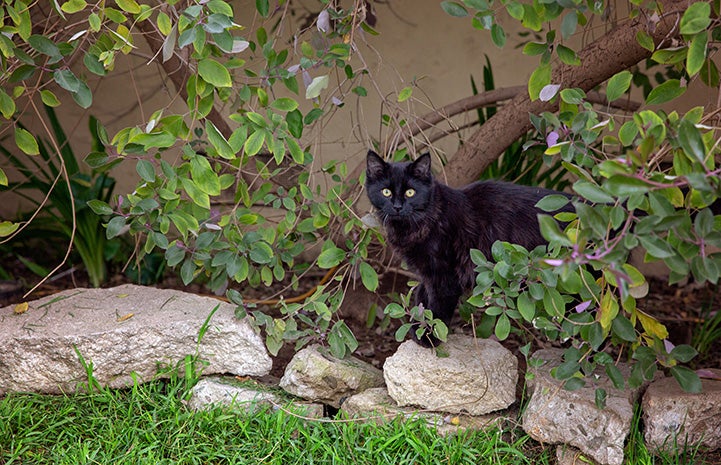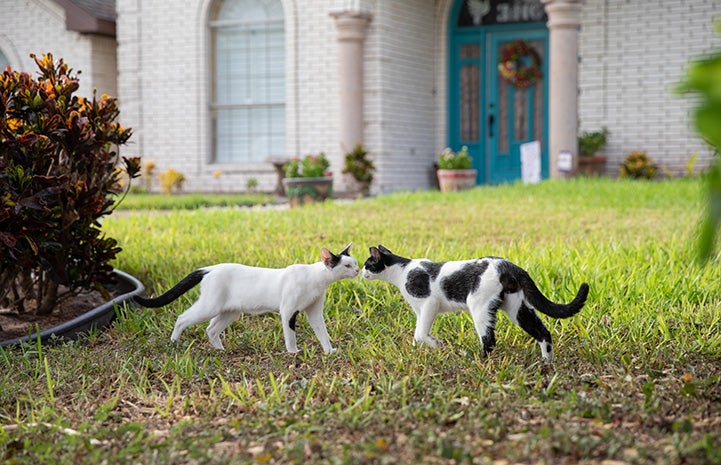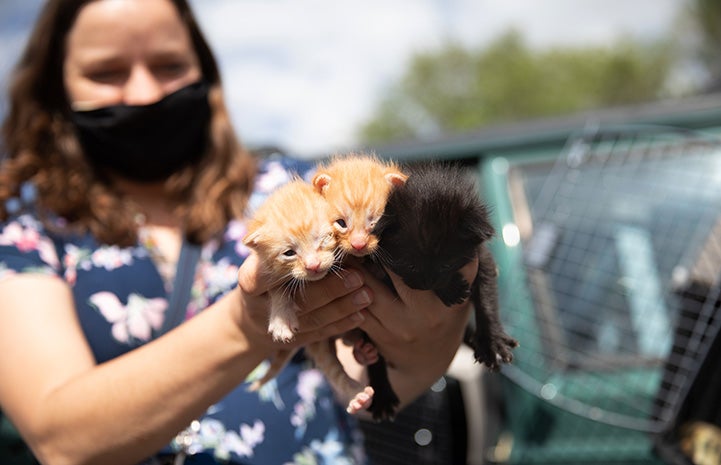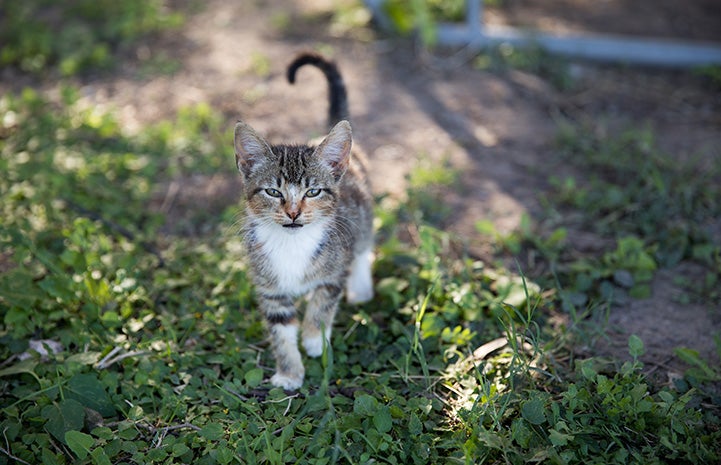Doing right by outdoor cats

“I’m seeing this new cat around, and I don’t know if he’s lost or if he belongs to someone. I want him to be OK, but I’m not sure what to do.”
This wouldn’t be an unusual comment from someone not involved in animal rescue. In this case, though, it came from a coworker of mine who has spent more than a decade working at Best Friends. She noticed the cat hanging out a few doors away and commented on his cuteness to the man who she thought was his person.
“He said, ‘Oh, that’s not our cat. I wish he’d go away. He comes around here because of all our bird feeders,’” she told me. “Now I’m asking myself: Am I supposed to intervene in some way? What if the guy decides to get rid of him? What is the right thing to do?”
Cat lovers want to do the right thing when they see an outdoor kitty. Knowing what the right thing is, however, can be challenging. Should they trap the cat for spay/neuter? Knock on doors in the neighborhood and post flyers to see if he belongs to someone? Or just assume he’s someone’s cat and leave him be?
[From two legs to four, a kitten’s journey]
If my coworker and I weren’t sure what step to take in this instance (and we have a combined 30-plus years of experience in animal welfare), how does the average person who wants to help cats know what to do?

Sometimes it takes a village
Let’s start with what not to do: Don’t scoop up the cat and take him to a shelter. More than two million cats enter shelters every year in this country and about 20% of them don’t make it out alive.
Sadly, the hope that people will find their lost cats via shelters is mostly false; the average reclamation rate for felines has been stuck under 5% for decades. Our best intentions are contributing to the killing of more than 550 cats and kittens every day, when they should lead us to decide the best thing to do based on each individual situation.
[Freed from dental pain, senior cat regains vivacious spirit]
While I can confidently say that most cats who live outdoors are not lost or abandoned, there are some ways to confirm that. “Cats who are a good weight with a nice coat are most likely cared for by someone,” says Jen Adkins, a specialist in Best Friends’ national embed program. “Confident body language — like a cat sauntering down the sidewalk or taking a leisurely bath on your lawn chair — is a sign that the cat is comfortable outside. Cats who are yowling, scared or in distress are the ones who need your help.”
OK, so that cat snoozing on your deck may not need assistance, but you still want to know if someone is watching out for him. In that case, do some detective work. That’s what Jen’s mom, Denise Dixon, did when a friendly neutered cat popped up on her back porch one day. Worried that he was lost, Denise had him checked for a microchip, and it turned out that he did indeed have one. Unfortunately, his people had not updated their contact details and Denise was unable to connect with them.
Next, she tried posting his picture on the Nextdoor app, which allows people to share all kinds of information with their neighbors. Many postings are about lost and found animals, making it a helpful tool for reuniting pets with their people. Soon enough, several neighbors replied to say, “I know that cat. He hangs out at our house.”
“His name is Bill now, at least at my mom’s house,” Jen says. “He’s called Bob somewhere else and Nala by a family down the street who thinks he’s a girl.” No single household claims Bill as their own. Instead, he belongs to the whole neighborhood. “My mom pointed out that Bill is a happy, healthy cat who happens to live outside much of the time, when he is not hanging out inside various people’s homes,” Jen says. “Everyone is genuinely invested in Bill.”

Seeking common ground
Bill’s story is an example of one component of community-supported sheltering, which involves handling some animal issues directly within the community, with support and resources from shelters or rescue groups as needed. This model of animal sheltering allows shelters to focus on helping cats who are sick or injured, surrendered by their owners or truly lost.
[The story behind the high-flying, almond-loving cat]
Though Denise had good results posting Bill’s photo on Nextdoor, such technology won’t reach everyone. You can also try creating a flyer and hanging it around the neighborhood or putting a breakaway or paper collar on the cat with a note asking if he belongs to anyone. The fastest and most effective way to reach people, however, is to knock on doors and talk to them.
For some people, though, speaking to strangers feels risky. What if they react negatively toward you for even asking about the cat? “There is so much anger in the world, it makes sense that we are worried about talking to people we don’t know,” says Holly Sizemore, Best Friends’ chief mission officer.
That may be the reason why several women who were feeding a group of outdoor cats in a New Orleans neighborhood had never spoken to anyone who lived there. Certainly, they had reason to believe the neighbors would not be supportive of the cats, since there were 30 of them living on the property of a woman who had gone into hospice care.
“The cats were going to the bathroom on people’s lawns and one of them killed someone’s chicken. All the neighbors hated it,” says Kenny Lamberti, chief engagement officer at Companions and Animals for Reform and Equity (CARE), who purchased the home next door to the cats. “But they hated the situation, not the cats.”
Kenny mediated between the feeders and his neighbors and came up with a solution. Working with local animal welfare organizations, they were able to relocate or adopt out 25 of the cats. The remaining handful were welcome to stay.
“Most people just want to live life without nuisance. We can help them accomplish that,” Kenny says. “Now the community loves those cats, one of whom hangs out on my porch, and another goes in and out of someone’s house.”
“I’ve been talking to people for decades about cat issues and you’re never going to find the best solution unless you talk to people,” Holly adds. “It’s about approaching people with an open mind and respect.”

Solutions front and center
If there is a single cat meandering about the neighborhood and you are the only one attached to her, you can still get the community to accept her by addressing any problems she is causing. The number one reason that cats become a nuisance is because they are not spayed or neutered. Fighting, yowling, spraying, producing kittens — all these issues trace back to unsterilized cats.
“When you find a cat outside with no identification, the first thing you should do is make sure that cat is fixed,” says attorney Stephanie Nichols-Young, president of the Animal Defense League of Arizona, which has spayed or neutered more than 140,000 cats since 2009. “Too many people spend months evaluating the situation and then we have kittens running around. Fix the cat and everything else can come after.”
What about that guy who was unhappy about the cat stalking birds on his property? Even that situation can be remedied, according to Christie Rogero, director of pet programs at the Jackson Galaxy Project. She manages to care quite harmoniously for both birds and outdoor cats on her property.
Christie advises people to get bird feeders that are as tall as possible to lessen the possibility that a predator will get to them. She sets the feeders up near trees so birds can land on those first as a lookout spot. “The birds use the lilac bush in my yard to get a good lay of the land before they eat. I keep the base trimmed so there are fewer hiding spots for cats,” she says. “Luckily, I don’t have a lot of ground-feeder birds, but I still clean up the seed as much as possible.”
If neighbors’ complaints about cats are related to issues like cats leaving footprints on their cars or digging in their gardens, those behaviors can be mitigated by using a car cover, putting plastic carpet runners with the spiked side up in the garden and installing a motion-activated deterrent that sprays water. Another option is to scatter fragrant items that don’t appeal to a cat’s sense of smell, such as fresh orange or lemon rinds and oil of lavender or eucalyptus.
[Escape artist cat choses home life over the great outdoors]
“A lot of times, people don’t even realize that there are easy solutions to these kinds of issues,” Jen says. “Those face-to-face conversations can be lifesaving for cats by putting an end to your neighbor’s frustrations. And what better way to start a relationship than by offering someone a solution to their problems?”

We can all do our share
Everyone has limitations, of course, around how much they can get involved with helping an outdoor cat who turns out to not have anyone caring for her. Some people can take a frightened, injured cat inside, search for her person and find a new home for her if that’s what is needed. Others can just get a healthy outdoor cat spayed or neutered and then returned to the neighborhood.
The thing is, you can’t choose the best option without doing some research. Knowing where your neighbors stand about free-roaming felines can help solve or prevent problems in the future. Though there are rare occasions when one angry neighbor insists that the cat be removed and issues threats, people who work in animal welfare say they are often surprised at how much community members are willing to help.
The best-case scenario could turn out to be like Bill’s. He’s a happy cat who brings joy to many people and has shown neighbors that they have something in common. And can’t we all use a little more of that these days?

How to help cats in your community
No matter where you live, you can help save cats' lives. There are so many ways to get involved and make a real impact, and it can be a lot of fun, too!
Get involved for cats near you
This article originally appeared in Best Friends magazine. You can subscribe to the magazine by becoming a Best Friends member.
Read more
Pandemic pets: where are they now?
Senior Chihuahua finds love and harmony with musician adopter
Injured, abandoned dog loses her leg but not her spirit
Photos by Sarah Ause Kichas and Lori Fusaro